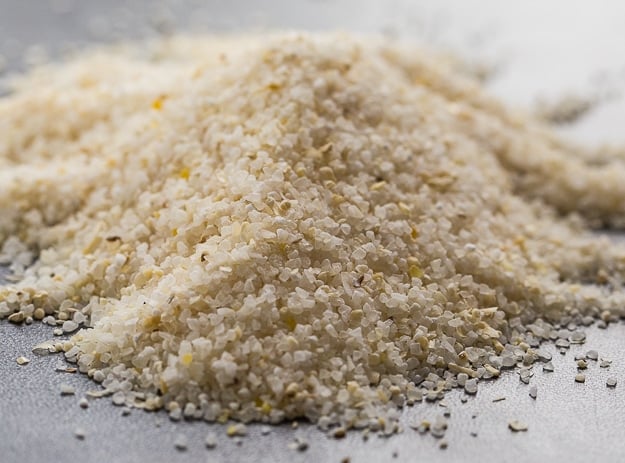
Is there anything more southern than grits? For most southerners they are an integral part of breakfast. A hot plate of creamy grits is pure comfort food. Outside of the south, little is known about grits. Continue reading and you’ll learn just about all you need to know about this quintessential southern food.
What Are Grits?
Grits are made from dried, mature corn kernels that are ground into smaller coarse bits. They are very similar to Italian polenta, but the two are typically made from very different types of corn and the fineness of the grind is also different. Polenta is more coarse.
Types of Grits
- Stone Ground Grits
- Hominy Grits
- Quick Grits
- Instant Grits

Hominy Grits- the hull and germ have been removed
Quick Grits are ground fine. Regular grits have a medium grind. They are both processed to cook quickly and last longer on store shelves.
Instant Grits have been precooked and dehydrated. It is often said that no self-respecting southerner would eat instant grits.
Some Favorite Stone-Ground Grits
Anson Mills– very popular among southern chefs.
Geechi Boy– family run business located in Edisto, SC.
Palmetto Farms – This is one of my favorite to use because it can be easily ordered from Amazon.com.
History of Grits
Grits have their roots in Native American culture. Native Americans would grind dried corn and make it into a mush. It is believed the name “grits” comes from the Old English word “grit” which means coarse meal. Gristmills, which turned locally grown corn into grits and cornmeal, used to be numerous in the south. They were often powered by water and stones were used to grind the corn down. Grits became a staple of southern cooking not only for their nutritional value, but because they were inexpensive.
Interestingly, the phrase “Nose to the Grindstone” comes from this process. It was essential that sense of smell be used to carefully monitor the process because stone grinding generates a great deal of heat and can cook the corn.
In the late 1800s many grist mills replaced stone grinding with steel-rollers.
How To Cook Grits
- Quick and Regular grits take 5 to 15 minutes to cook; Stone-Ground Grits can take anywhere from 30 to 60 minutes.
- Stone-ground Grits can be soaked in water overnight, but it is not necessary.
- Always salt the water. Cooked grits do not pick up the flavor of salt very well.
- Cook in a ratio of 1 cup grits to 4 cups liquid.
- Grits can be cooked in water or a mixture of water and chicken broth or a mixture of water and milk (half and half or cream)
- There is no right or wrong when it comes to consistency of grits; some like thick grits, others like them a little runny.
- Bring liquid to a boil and gradually whisk in grits. Continue to whisk for at least 30 seconds to avoid clumping.
- Covering grits while they cook will reduce cooking time.
- Grits should be cooked at a simmer.
- Grits should be stirred periodically while they cook to prevent sticking and clumping.
- If grits are getting too thick, add more liquid.
- Stir in butter and cheese (if using) at the end.
- Stone-Ground Grits are very perishable and should be stored in the freezer.
Recipes With Grits
Crock Pot Grits – One of the easiest ways to cook grits. Put them in the crock pot before you go to bead and the next morning you have warm grits ready to go!
Cream Cheese Grits – a touch a cream cheese makes these grits super creamy!
Shrimp and Grits – turn grits into a sophisticated dinner with this easy recipe. Interestingly, Shrimp and Grits began as a simple breakfast food for fishermen, but now has become a gourmet meal served at many upscale restaurants.
Grits Fritters with Red Pepper Jelly Dipping Sauce – made from cheese grits with bacon, corn, and green onions. Coated in Panko crumbs and deep fried until crispy. Such a great southern appetizer.
Gifts For Grit Lovers
Glorious Grits: America’s Favorite Comfort Food is full of beautiful pictures and well-written recipes including Huevos Rancheros on Cilantro-Grits Cakes and Southwestern Grits Stuffed Peppers. You won’t believe all the possibilities for grits!
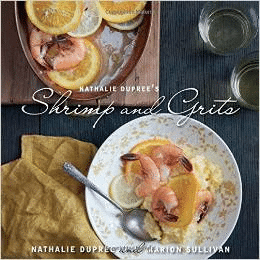
cookbook from one of the South’s most prolific cookbook authors includes such recipes as Grits Waffles and Squash and Apple Soup with Shrimp and Grits Cakes.
Grits Bits are a southern snack food made in Georgia. These delicious baked snack biscuits with Vidalia onion and cheese are perfect for serving with a glass of wine.
Disclosure: This post contains affiliate links.
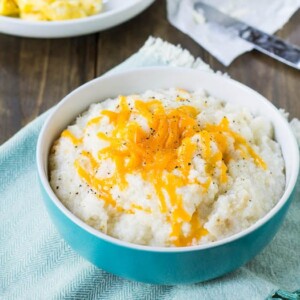
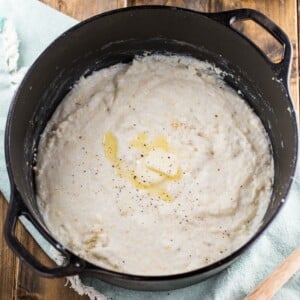
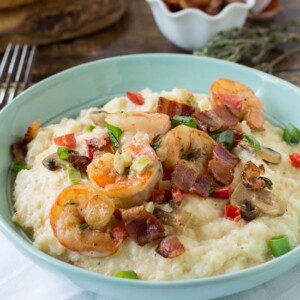
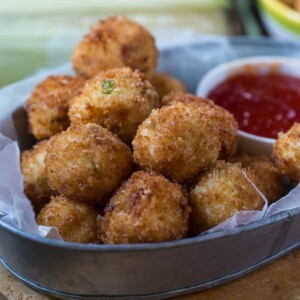

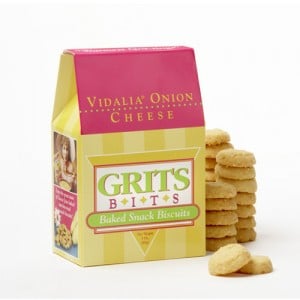

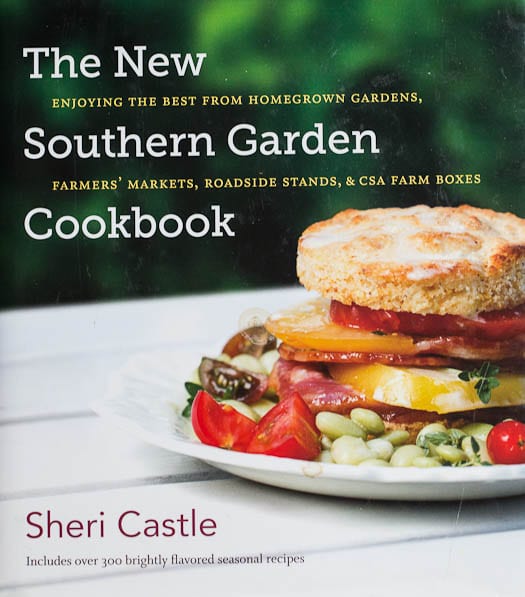









I get my grits from Logan Turnpike Mill out of Blairsville, GA. They are stone ground and shipped fresh out of the mill. They have both white and yellow speckled grits, cornmeal and other flours. I will have to check out the other mills mentioned. I have been getting grits and cornmeal from them for over 30 years.
They can be found at: https://loganturnpikemill.com/
While grits was something Native Americans used, it’s not something new. Nearly all cultures have ground porridge of some kind. The grits that are known to be “Southern” or “America’s favorite” were created by enslaved Africans (like shrimp and grits), 99.9% of cuisine labeled as “Southern,” was created by enslaved Africans. Funny how that seems to get skipped over.
Funny how some people feel a need to make EVERYTHING about race and racism. Skipped over? Good Lord! Also, while I don’t doubt grits were a staple of all people living in the south, how about you explain how they were created by “enslaved Africans” when they weren’t “enslaved Africans” until they were brought to this continent, a continent already populated by the Native Americans you admit were using them. Would that not logically suggest grits were being used by them before enslaved Africans were brought here? Not that it really matters but I’m just beyond sick & tired of every damn thing I read or see on TV suggesting that racism permeates every facet of our society, in other words “systemic”. Racism exists, and likely always will, and it is an ugly thing, but so is claiming it where it does not exist, and using it for political purposes by a party that thrives by creating divisions between races, classes, etc., and by convincing entire cultures, races, etc., they are victims, thus needing that party to make things better.
Christian – If you can I would appreciate some help. Am trying to make some cheese straws that have grits (kinda like GritsBits). Since I only know how to make them in crock pot (at least so I know they turn out correct) I am perplexed. I am (sorta) a trial & error cook at times but this one has me stumped since I don’t know properties of grits in baked goods. ANy helpyou can give would be appreciated
What kind would I add to my cheese straw “batter”?
Already cooked per what kind I am making?
Quantity either way I add them?
oh I failed to mention that I went with my aunt to have the corn ground in town. yeph , good memories. we no longer have a grist mill. dont have as many small farms. and sho nuff 2 syllable gree its.
and blue ribbon cane syrup and fresh cow butter and cream and milk. unpasturized and we never got sick.
and churning ice cream on the back porch in a big ol manually churned ice cream maker…..they would cover the top with burlap and we kids took turns sitting on it to keep the lid fastened down good and tight.
Grits, grits and more grits. We had them almost every day. My yankee cousins would visit in the summer, they always got us confused. Whereas we cook grits in water with a dash of salt and pepper and a dollop of butter or margarine. They add nothing to the water and eat them with sugar and milk. And just the opposite for oatmeal. It was always a riot trying to prepare meals that everyone would eat. We all enjoyed watermelon and fresh from the garden corn on the cob, and freshly dug potatoes sliced in the round and fried, and good ol tomato gravy and biscuits.
Does any one know where to buy yellow (nixtamalized) hominy grits? I’ve searched high and low without results…
Interesting question. What I did was get some corn kernels, buy pickling lime, and do my own nixtamalization. There are videos on youtube about this. I simmer the kernels in water to cover ++- 1-2# of corn kernels to 1/4- 1/3c of pickling lime (I think the brand I got was Mrs. Wage’s- simmer for 2hrs in a s/s pan, let set o/n, then drain and rinse WELL, rubbing the kernels to remove the pericarp. Then grind (wet) in a in a meat grinder (coarse>med>fine) and either use wet to make tortillas (you can buy a press), dry in a dehydrator to make a nubbly form of grits- OR- dry the whole nixtamalized kernels to grind in a grain grinder and make your own grits. They still have the germ attached- so are technically more nutritious. I’m now RIGHT off the deep end and growing multiple varieties of corn for this project- Oaxacan green, bhahdiblahdiblah…
We have grits every weekend. Born and raised in the south I now live in Ohio my husband (born and raised here) loves my grits and southern cooking.
Crock pot grits are the best. Liquid used should be 2/3 water & 1/3 milk. Crock pot on low for 6 hours. hmmmm… hmmmmm… good. 3 1/3 cups liquid to 1 cup quick grits, not instant. Stone ground grits are not the best. Add hot water if needed after 6 hours for desired consistency.
i love grits too
If one comes across an older deep south-born-and-raised native you may hear it pronounced with two syllables. Gree-its. It makes me grin with glee every time, remembering my southern upbringing. I rarely hear it any more.
I must admit that I’ve only had grits a few times, though I do like them. And I never knew there were so many different kinds! The quick grits sound tasty, though I think I’ve only ever had the instant kind. Thanks for sharing!
oh I failed to mention that I went with my aunt to have the corn ground in town. yeph , good memories. we no longer have a grist mill. dont have as many small farms. and sho nuff 2 syllable gree its.
and blue ribbon cane syrup and fresh cow butter and cream and milk. unpasturized and we never got sick.
and churning ice cream on the back porch in a big ol manually churned ice cream maker…..they would cover the top with burlap and we kids took turns sitting on it to keep the lid fastened down good and tight.